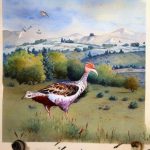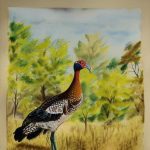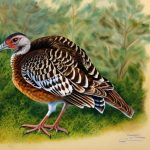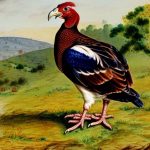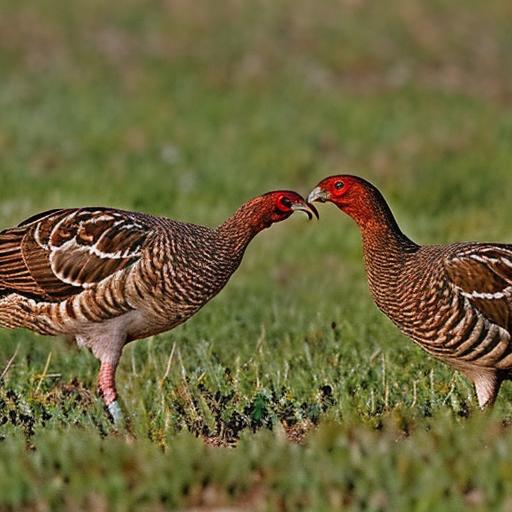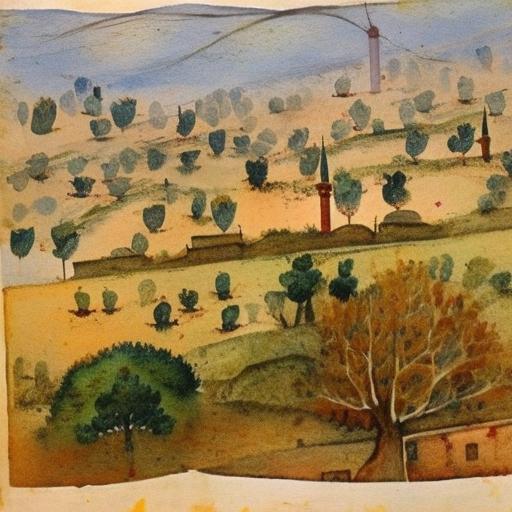The brush turkey, also known as the Australian brush-turkey or bush turkey, is a large, ground-dwelling bird native to Australia. These fascinating birds are known for their unique breeding behaviors and impressive nesting mounds. Brush turkeys belong to the family Megapodiidae, which includes other species of mound-building birds found in Australia, New Guinea, and nearby islands. They are known for their distinctive appearance, with a bare, red head and neck, and a black body with a glossy sheen.
Brush turkeys are primarily found in the rainforests and dense woodlands of eastern Australia, where they forage for food on the forest floor. They are omnivorous birds, feeding on a variety of insects, seeds, fruits, and small vertebrates. During the breeding season, brush turkeys become particularly active as they engage in courtship displays, nest building, and egg-laying. This period is crucial for the survival of the species, as it ensures the continuation of their population. Understanding the breeding season of brush turkeys is essential for conservation efforts and the protection of these unique birds.
Table of Contents
Key Takeaways
- Brush turkeys are large, ground-dwelling birds native to Australia and New Guinea.
- The breeding season for brush turkeys typically occurs from September to March.
- Signs of brush turkey breeding season include males building large mounds of vegetation and females laying eggs in the mounds.
- During breeding season, male brush turkeys display aggressive behavior and compete for mating rights with females.
- Female brush turkeys lay their eggs in the mounds and rely on the heat generated by the decomposing vegetation to incubate the eggs.
Overview of Brush Turkey Breeding Season
The breeding season for brush turkeys typically occurs from September to March, coinciding with the warmer months in Australia. During this time, male brush turkeys become highly territorial and engage in elaborate courtship displays to attract females. The males will often build multiple nesting mounds in their territory to entice potential mates. These mounds are constructed from leaves, twigs, and other organic materials found on the forest floor. The male brush turkey will spend hours meticulously arranging and tending to the mound, ensuring it reaches the optimal temperature for incubating eggs.
Once a female has been attracted to a male’s nesting mound, she will inspect the mound and, if satisfied, will lay her eggs within it. The male will then cover the eggs with additional organic material to protect them from predators and regulate the temperature. After the eggs have been laid, the male will continue to monitor the mound, adjusting its temperature as needed to ensure the successful development of the embryos. The breeding season is a critical time for brush turkeys, as it determines the success of their reproductive efforts and ultimately impacts the population size of the species.
Signs of Brush Turkey Breeding Season
During the breeding season, there are several signs that indicate the heightened activity of brush turkeys. One of the most noticeable signs is the presence of large nesting mounds scattered throughout their habitat. These mounds can reach impressive sizes, often exceeding two meters in diameter and one meter in height. The presence of these mounds is a clear indication that brush turkeys are actively engaged in breeding behaviors.
Another sign of the breeding season is the increased vocalization and activity of male brush turkeys. Males will often be heard calling loudly from their territories as they attempt to attract females. Their calls are distinctive and can be heard echoing through the forest as they compete for mates. Additionally, male brush turkeys may be observed engaging in elaborate courtship displays, including fanning their tails and puffing out their chests to display their vibrant plumage.
Furthermore, sightings of female brush turkeys inspecting nesting mounds or laying eggs within them are clear indicators that the breeding season is underway. These signs collectively contribute to our understanding of brush turkey breeding behaviors and provide valuable insights into their reproductive ecology.
Behavior of Brush Turkeys During Breeding Season
During the breeding season, brush turkeys exhibit a range of fascinating behaviors as they engage in courtship rituals and nest building activities. Male brush turkeys become highly territorial and will vigorously defend their nesting mounds from rival males. They will also spend considerable time constructing and tending to their mounds, ensuring they are suitable for attracting females.
Courtship displays are another prominent behavior observed during the breeding season. Male brush turkeys will strut around their territory, displaying their vibrant plumage and vocalizing loudly to attract females. These displays can be quite elaborate and are essential for enticing potential mates.
Once a female has chosen a male’s nesting mound, she will lay her eggs within it, and the male will take on the responsibility of incubating them. He will carefully monitor the temperature of the mound, adjusting it as needed to ensure the successful development of the eggs. This behavior is crucial for the survival of the embryos and demonstrates the dedication of male brush turkeys to their reproductive efforts.
Overall, the breeding season brings about a significant shift in the behavior of brush turkeys as they focus their energy on courtship, nest building, and egg-laying activities. Understanding these behaviors is essential for conservation efforts aimed at protecting this unique species.
Nesting and Egg-laying of Brush Turkeys
Nesting and egg-laying are central aspects of the breeding season for brush turkeys. The construction of nesting mounds is a key behavior exhibited by male brush turkeys during this time. These mounds serve as incubation chambers for the eggs and are meticulously built using organic materials found on the forest floor. The male will spend hours arranging leaves, twigs, and soil to create a mound that can reach impressive dimensions.
Once a female has chosen a nesting mound, she will lay her eggs within it. Female brush turkeys typically lay between 18 to 24 eggs over several days, with each egg being carefully placed within the mound by the female. After all the eggs have been laid, the male will cover them with additional organic material to protect them from predators and regulate their temperature.
The incubation period for brush turkey eggs is approximately 50 days, during which time the male will diligently tend to the mound, adjusting its temperature as needed to ensure the successful development of the embryos. Once the eggs hatch, the chicks will emerge fully feathered and capable of independent movement. Nesting and egg-laying behaviors are critical components of the breeding season for brush turkeys and play a significant role in determining the success of their reproductive efforts.
Impact of Breeding Season on Brush Turkey Population

The breeding season has a profound impact on the population dynamics of brush turkeys. During this time, individuals become highly focused on reproductive activities, including courtship displays, nest building, and egg-laying. The success of these efforts directly influences the size and health of the population.
The construction of nesting mounds by male brush turkeys creates important microhabitats within their environment. These mounds provide shelter for developing embryos and contribute to the overall biodiversity of the ecosystem. Additionally, successful egg-laying and incubation lead to an increase in the number of young brush turkeys entering the population.
However, breeding seasons can also be challenging for brush turkey populations due to factors such as predation and habitat loss. Nesting mounds are vulnerable to disturbance from human activities or natural predators, which can impact the survival of developing embryos. Furthermore, habitat destruction and fragmentation can limit the availability of suitable nesting sites for brush turkeys.
Understanding the impact of breeding seasons on brush turkey populations is crucial for conservation efforts aimed at protecting these birds and their habitats. By addressing threats such as habitat loss and predation, conservationists can help ensure the long-term viability of brush turkey populations.
Conservation Efforts During Brush Turkey Breeding Season
Conservation efforts during the brush turkey breeding season are essential for safeguarding the future of this unique species. One key conservation strategy is habitat protection and restoration. Preserving intact rainforest and woodland habitats provides essential nesting sites for brush turkeys and supports their reproductive efforts. Additionally, restoring degraded habitats can create new opportunities for nesting mounds and contribute to population growth.
Another important conservation measure is predator management. Implementing strategies to reduce predation on nesting mounds can significantly improve the survival rates of developing embryos. This may involve controlling invasive species or implementing measures to minimize human disturbance in brush turkey habitats.
Community engagement and education also play a vital role in conservation efforts during the breeding season. By raising awareness about the importance of brush turkeys and their breeding behaviors, local communities can become advocates for their protection. This may involve outreach programs, educational initiatives, and citizen science projects aimed at monitoring brush turkey populations.
Furthermore, research into the reproductive ecology of brush turkeys can provide valuable insights that inform conservation strategies. Understanding factors such as nesting success rates, incubation behaviors, and habitat requirements can guide targeted conservation efforts that support breeding populations.
In conclusion, conservation efforts during the brush turkey breeding season are crucial for ensuring the long-term survival of this iconic Australian bird. By addressing threats such as habitat loss, predation, and human disturbance, conservationists can help protect brush turkey populations and preserve their unique breeding behaviors for future generations to appreciate and enjoy.
If you’re interested in learning more about the breeding habits of brush turkeys, you might also want to check out this informative article on what to feed ducks. Understanding the dietary needs of waterfowl can provide valuable insights into the natural behaviors and breeding patterns of various bird species.
FAQs
What is the breeding season for brush turkeys?
The breeding season for brush turkeys typically occurs from September to March in Australia.
How do brush turkeys breed?
Male brush turkeys build large mounds of vegetation, which they use to attract females. The females then lay their eggs in the mound, and the male is responsible for regulating the temperature of the eggs by adding or removing vegetation.
How many eggs do brush turkeys lay?
Female brush turkeys can lay up to 24 eggs in a single breeding season.
How long does it take for brush turkey eggs to hatch?
It takes approximately 50 days for brush turkey eggs to hatch.
Are brush turkeys protected during breeding season?
Yes, brush turkeys are protected under Australian law, and it is illegal to disturb their breeding mounds or eggs.
Meet Walter, the feathered-friend fanatic of Florida! Nestled in the sunshine state, Walter struts through life with his feathered companions, clucking his way to happiness. With a coop that’s fancier than a five-star hotel, he’s the Don Juan of the chicken world. When he’s not teaching his hens to do the cha-cha, you’ll find him in a heated debate with his prized rooster, Sir Clucks-a-Lot. Walter’s poultry passion is no yolk; he’s the sunny-side-up guy you never knew you needed in your flock of friends!


